Robin Hood: the time of the hero and his possible prototypes
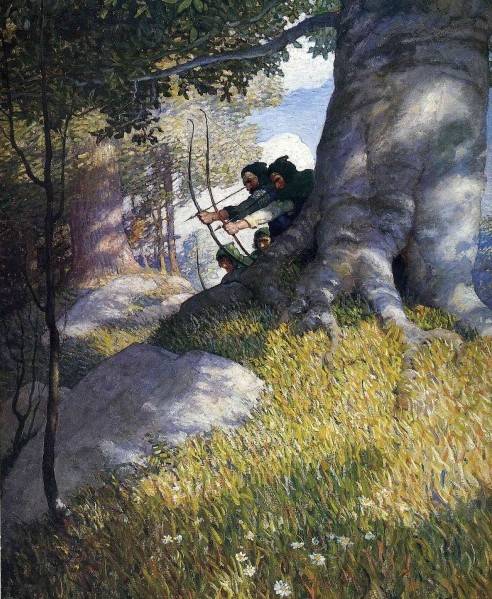
Illustration by N. Wyeth, 1917
Robin Hood is by far the most famous robber in the world. stories, and not a simple robber, but a “noble” one. His very name has become a household name and is on a par with such names as Don Quixote, Don Juan, Shylock, Manilov, and some others. Far from England CaliforniaMexican Robin Hood” was called Joaquin Murieta, who “traded” there during the Gold Rush (in the middle of the XNUMXth century), became the hero of numerous books, films and the famous rock opera by A. Rybnikov. Of course, this “Ghost of Sonora” did not share the stolen goods with the poor, but it robbed only the rich - and that was enough. After all, you see, many in Russia would be happy to read news about the fact that somewhere in Tel Aviv or Haifa in a dark alley "they took on a gop-stop" one of the crooks who escaped from Russia - Khodorkovsky, Abramovich, Chubais and the list goes on. It is quite possible that in the case of Robin Hood there was a similar situation. The popularity of the “robber from Sherwood Forest” is also evidenced by the fact that on the sea coast of North Yorkshire there is Robin Hood’s bay, where, according to a XNUMXth-century ballad, he defeated French pirates and gave half of the treasure he obtained to the local poor to build a house.
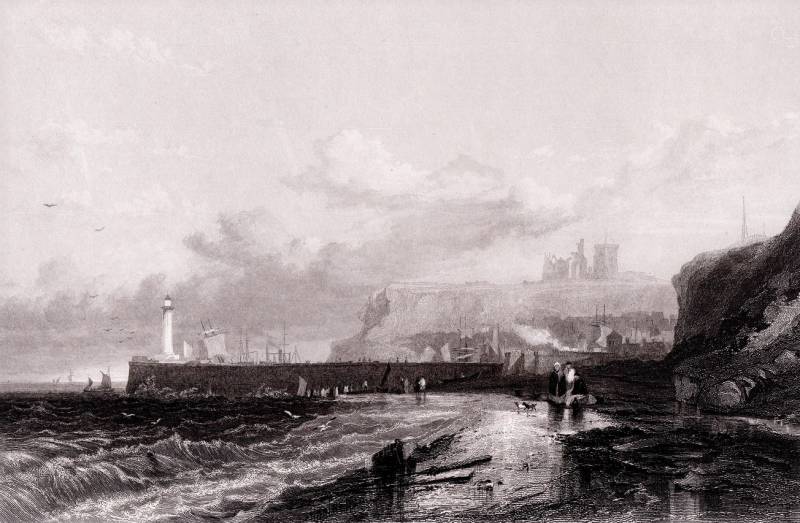
Robin Hood's Bay in an 1842 engraving
Hero time
Since the publication of Walter Scott's Ivanhoe, the vast majority of people have been convinced that Robin Hood was a contemporary of King Richard the Lionheart.
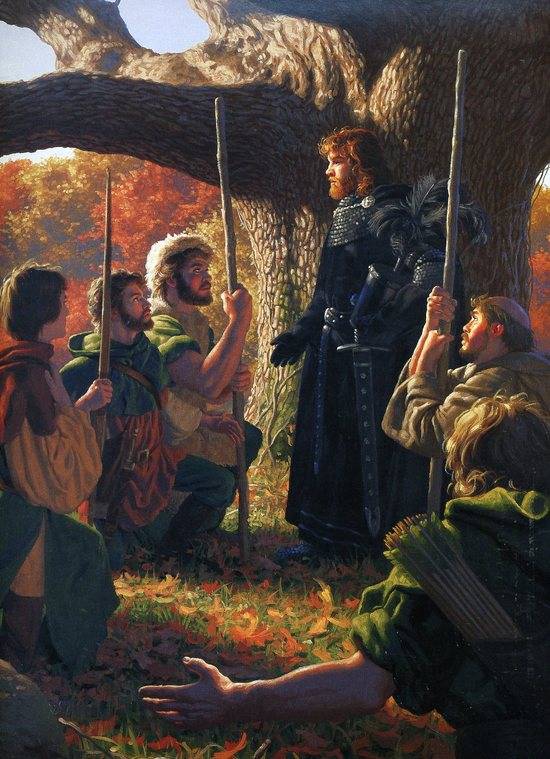
Greg Hildebrandt. King Richard the Lionheart and the Robbers of Sherwood Forest, illustration for Walter Scott's Ivanhoe
And through the efforts of Western filmmakers, Robin Hood also became a nobleman, a sort of Dubrovsky, who went to Sherwood Forest due to life circumstances. To what extent are these points of view justified? First, let's try to determine the lifetime of the alleged prototype of this charming character.
It has long been noted that the romanticization and glorification of all kinds of robbers usually occurs against the backdrop of a sharp deterioration in the financial situation of the common people. Therefore, the time of the reign of Richard the Lionheart seems quite suitable for creating the legend of the noble robber and the "good fellow" Robin Hood. Going on a crusade, this king pretty much robbed all the English. On the advice of William de Longchamp, he even put up for sale all the public offices of the kingdom, giving out some brilliant jokes (although the British were not funny then). So, having sold the County of Norampton to the Bishop of Durham, Richard declared that “made a young earl from an old bishop". His phrase went down in history:
Nobody bought London from him, but there was a buyer for Scotland, which was conquered in 1174 by his father Henry II, who captured the local monarch in the battle of Alnwick. The future Scottish king William wished to buy it in 1189. The new English king sold him an entire country for a cheap price of 10 silver marks. Later, for Richard himself, who was captured by the Austrian Archduke Ferdinand upon returning home, a ransom of 150 thousand marks was paid - so Richard robbed the British for the second time, and again on a grand scale - where is Robin Hood. But the same archery competitions described in the ballads only became popular in England in the 1378th century. And the first mention of Robin Hood in a written source was recorded only in XNUMX - in the literary work of William Langland "The Vision of Peter Plowman". The illiterate priest says:
That is, already in the second half of the XIV century, ballads about this robber were not only known in England, but also very popular. The middle of the 1381th century is also a good time for the appearance of the legend of Robin Hood - in this case, he turns out to be a contemporary of Wat Tyler, who led the rebels who captured London in XNUMX. It is curious, by the way, that among the rebels then pardoned by King Richard II, there was a certain Robert Hode (Hode), also called Robert Dore (Dore) of Wadsley. It seems that around this time, stories about an atypical robber who robs the rich and distributes the booty to the poor began to actively spread in England (and he, apparently, “lives on interest”). However, the robbers have chosen Sherwood since time immemorial, and the government managed to deal with them only at the very end of the XNUMXth century. So Robin Hood could have several prototypes.
Prototypes of some associates of Robin Hood
At the end of the XNUMXth century, the ballad "Robin Hood and the Sheriff" was recorded, in which the monk Tuk appears.
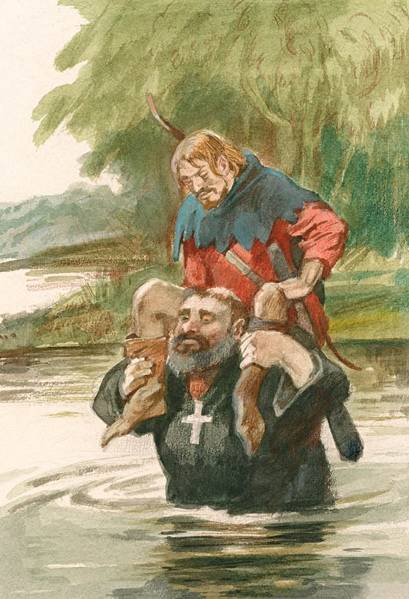
Robin Hood and Brother Took in the illustration by A. Itkin
This is by no means a parody character. The morals that reigned in medieval English monasteries can be judged by the scandalous story that happened at the beginning of the XIV century. In 1306-1315. the hotel of Sherwood Kirklees Monastery was turned into a brothel, and even the names of the nuns who “worked” in it have survived: Ellis Raggedy, Elizabeth Hopton and Joan Heaton. So Brother Took's "joie de vivre" did not surprise anyone in England.
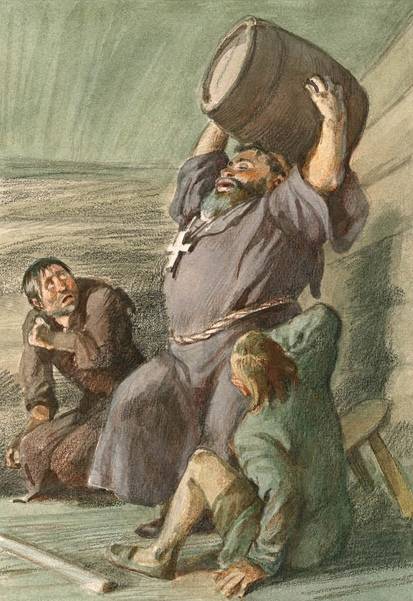
Brother Took illustrated by A. Itkin
Some believe that the prototype of Took was the priest from Sussex, Robert Stafford. In one of the sources it is reported that in 1417 this "holy father" joined the robbers.
In the ballad "Robin Hood and the Monk" recorded in the same XNUMXth century, such a colorful character as "Little John" appears. He was the best with a club (or staff) and he even managed to defeat Robin Hood.
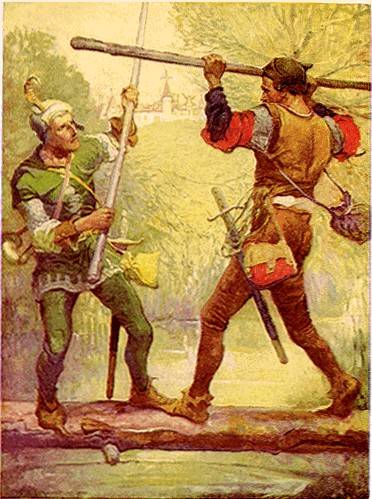
Robin Hood and Little John illustrated by Louis John Reid
Its prototype may be John Le Little, which, according to the "Chronicle" of the Scot Andrew Winton (compiled around 1420) in 1283-1285. robbed with a certain Robin Hude (Robyne Hude).
It is curious that one actor - Alan Hale, managed to play the role of Little John three times: as a young man (1922), a mature man (1938) and an old man (1958).
In the alleged grave of this "Kid" at the end of the XNUMXth century, the remains of a man about two meters ten centimeters tall were discovered.
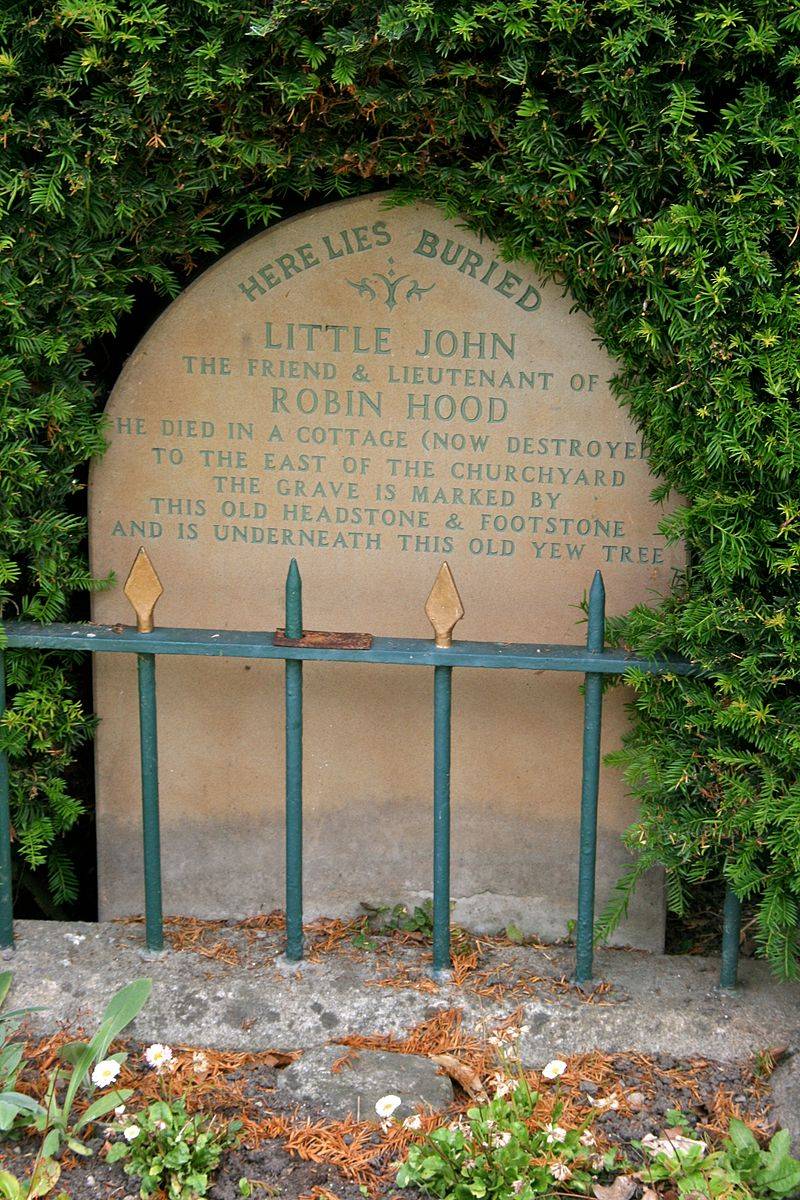
Supposed grave of Little John, Hathersage
But you never know in the centuries-old history of England there were thugs in this country with the ironic nickname "Little John", "Little John", "Little John" and so on?
Now let's talk about the possible prototypes of Robin Hood himself.
Prototypes of the "noble robber"
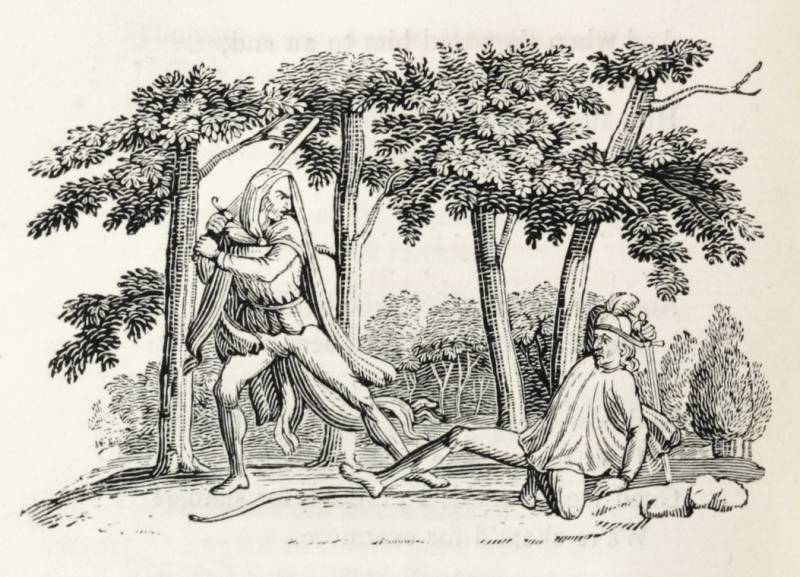
T. Buick. Robin Hood and Guy of Gisborne, woodcut, 1832
The first assumption that Robin Hood has a real prototype was put forward by Joseph Ritson in 1795. I must say that the question of the origin of this hero is very complex and has not yet been resolved. There are different versions, which we will try to consider in this article.
First, let's try to determine what the name Robin means. The easiest way is to assume that it is a diminutive of Robert, and Good is “good”. But according to one version, the name of the Sherwood robber is a nickname and comes from the name of the robin bird (“Robin”). Some even believe that the well-known children's song "Who Killed Cock Robin?" can be associated with it. It is curious that a dove acts as a mourner in it - a symbol of the Virgin Mary, who in this case is identified with the beloved of the hero - Marian. But why exactly a robin? Not an eagle, not a hawk, not a kite? They try to explain this by the fact that in England a robin that flew into a house foreshadowed trouble, even a dead person in the family - as well as a visit to this house by a gang of robbers. But meeting this bird on the street during the cold months of the year was a good omen - a hint of the help that Robin Hood provided to the poor?
Supporters of another version also consider the name of the hero to be a nickname, but they believe that the leader of the Sherwood gang was originally called Robber in hode - "The robber in the hood." However, the word "hode" can also mean a knight's helmet. Moreover, it has been noticed that in the early ballads the “hooded Robin” (or even in a helmet) hiding his face acts, and in the later ones, the cheerful yeoman Robin Hood.
However, the word yeoman (yeoman - from youngerman) is also “with a double bottom”. Previously, it was often used in the meanings of "young man", "younger member of the family", "servant". And only since the reign of Elizabeth "yeoman" began to unambiguously call a peasant who owns a small plot of land. But even under this queen, bodyguards were also called "yeomen of the guard", and the guards of the Tower -"prison yeomen».
That is, Robin Hood could be the youngest son of a noble family, who, according to Salic law, was forced to serve the eldest in the family or look for a patron on the side. It was on these grounds that a version of the "noble" origin of Robin Hood appeared. Supporters of this version most often call the Scottish earl David Huntington, who was not a “youngerman”, the prototype of Robin Hood. It is known that David Huntington (1144-1219) was a hostage for several years at the court of King Henry II. And in the “Robin Hood Gesture” written around 1450, it is said that the Sherwood robber spent 15 months at the royal court.
(The gesture, Chanson de geste, "The Song of Deeds" is a genre of French medieval literature, the most famous gesture is the "Song of Roland").
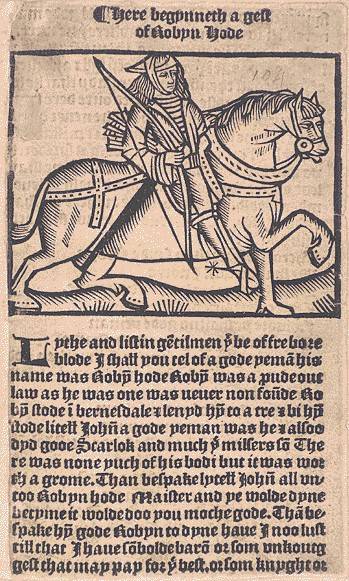
The first sheet of the "Small gesture about Robin Hood", XVI century.
In another ballad, the name of the king who then ruled England is called Edward. There were three monarchs with this name, and they ruled from 1272 to 1377. And David Huntington was a supporter of Richard the Lionheart, went on a crusade with him, actively supported him after returning to England. Later, in 1194, David participated in the siege of Nottingham, where his brother John (Landless) was hiding from the returning Richard. However, this earl has nothing to do with Sherwood Forest.
Another candidate for the role of Robin Hood is called the son of David Huntington - Robert, who allegedly did not die at a young age, but fled to Sherwood Forest. Over time, he allegedly intended to declare his rights to the Scottish throne. But it wasn't until the reign of Queen Elizabeth (1558-1603) that Anthony Munday wrote two plays that portray Robin Hood as Earl Robert of Huntington.
In 1697, thanks to the antiquary Thomas Gale, a grave located in the forest 650 meters from the gatehouse of the former Cistercian Kirklees monastery mentioned above (West Yorkshire) became widely known. The epitaph on this grave read:
This monastery is called the place of death of the hero in the mid-XNUMXth century “Gesture of Robin Hood” and the ballad “Death of Robin Hood” recorded in the XNUMXth century. There are two versions of the death of this hero. According to the first, the insidious abbess of the monastery, to whom the ill hero turned for help, simply allowed him to bleed after the bloodletting procedure (this was described in detail in the article Famous victims of "medicated bloodletting" and followers of Duremar). According to another, she brought the killer - Sir Roger of Doncaster. Some versions of the ballad say that this woman was the sister of Marian - the beloved of Robin Hood.
A later version of the ballad, recorded as early as 1786, claims that Robin Hood ordered Little John to be buried in the place where the arrow he fired would fall.
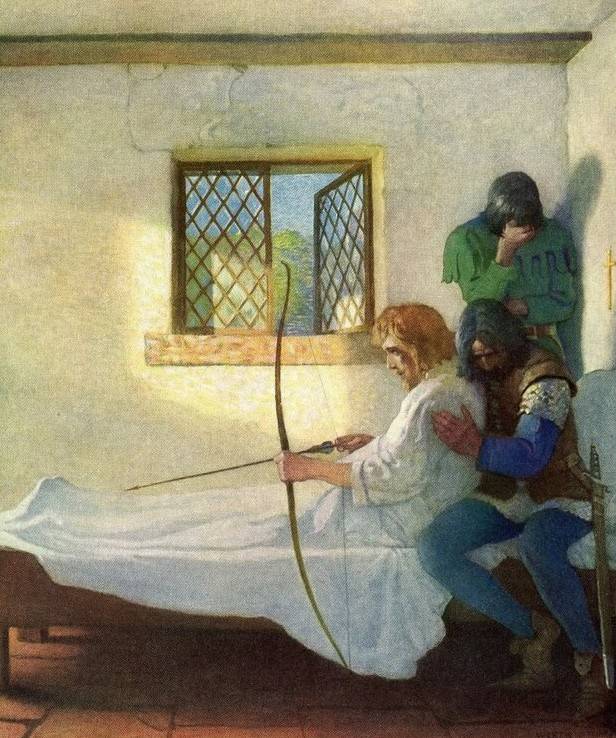
Dying Robin Hood illustrated by N. Wyeth, 1917
Modern historians consider the inscription on this grave to be fake, since its language clearly does not correspond to the time, and local peasants have never associated this burial with the name of Robin Hood, popular throughout England. In addition, this inscription was not known until the end of the XNUMXth century. Yes, and it is difficult to expect virtuoso possession of a bow from an aristocrat - this weapon free peasants who learned to handle it from childhood.
Ballads are known in which Robin Hood appears as the illegitimate son of the daughter of a non-existent Richard Huntington and even an unnamed English king.
William Stukeley suggested that Robert fitz (son) Odo of Loxley, who was deprived of his estate in 1196, could be hiding under the name Robin Hood. This knight was a contemporary of Richard the Lionheart, but kept the side of his brother, John (John) Landless, for which is likely to have been damaged. Other candidates for the role of the "noble robber" were Robert Hood, Robert Hobbehod and Robert Smith, nicknamed Robhoud. All of them were outlawed: the first - and in 1213 the second - in 1255, the third - in 1261. And Roger Hodberd was captured in 1272 not just anywhere, but in Sherwood Forest. A certain Robert Hoad, a supporter of Thomas Plantagenet, Earl of Lancaster, was hiding from the authorities in this forest in 1322. His candidacy was proposed in 1852 by Joseph Hunter.
All these assumptions do not look very convincing. Against the versions of the “noble” origin of Robin Hood, the fact that in the aristocratic and noble environment this hero of popular ballads becomes popular only at the beginning of the 1510th century speaks against the versions. So, they say that in XNUMX King Henry VIII dressed up as Robin Hood, his courtiers - other robbers. All together, for fun, they broke into the bedroom of Queen Catherine of Aragon. Aristocrats, naturally, wanted the "noble robber" to be their equal, and not some kind of rootless peasant. Contradicts the version of the "noble" origin of Robin Hood and the original image of the maiden Marian. In the earliest ballads, she also appears as Clorinda or Matilda and is called either a maid, or a shepherdess, and even the mistress of the monk Took. Only in later times did Marian turn into a noblewoman and lover of Robin Hood. Probably, court writers, as usual, conscientiously fulfilled the “state order”, correcting the images of popular heroes in the right direction.
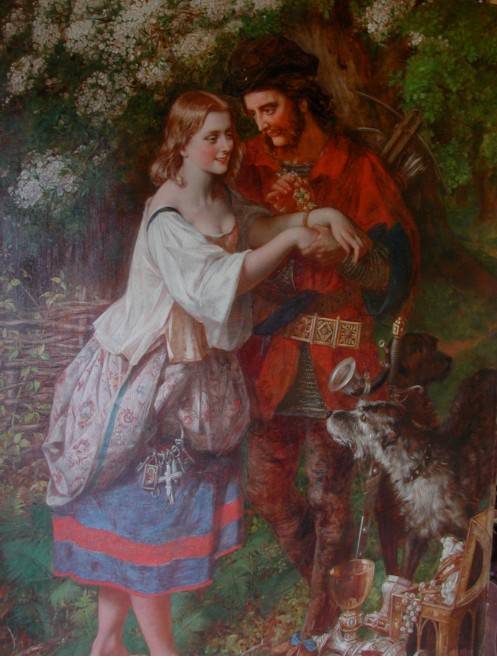
T. F. Hafey. Robin Hood and Maid Marian, 1866
By the way, in the last quarter of the XNUMXth century in Naples, the Frenchman Adam de la Alem wrote the pastoral “The Game of Robin and Marion”. Here we see a simple coincidence of names: in this work there are no robbery or heroic storylines. However, it is believed that the image of the girl of this pastoral could have influenced the image of Marian in later English ballads. So, Marian in the form of Clorinda is sometimes called the "queen of shepherds."
Returning to the question of the origin of Robin Hood, we still have to admit that the version seems more reliable, according to which he was a yeoman, a free peasant who, for some reason, was forced to leave his house and go into the forest. And, probably, the features of several successful and popular leaders of Sherwood robbers merged in his image. Gradually, new stories were added to the legends, possibly compiled already in the XNUMXth century, or they were corrected in accordance with the changing socio-political situation - until the well-known "canonical" image of the "noble robber" was formed.
In the next article, we will continue and finish the story about this hero.
Information